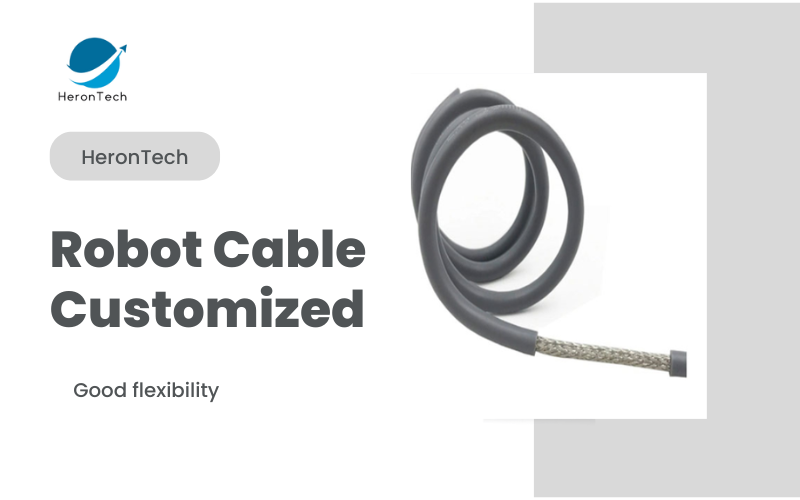The Role of Robot Cables in Industry 4.0
As we advance into the era of Industry 4.0, the integration of robotics and automation technology is reshaping industrial landscapes across the globe. Central to this transformation are robot cables, which play a crucial role in enabling the seamless operation of modern robotic systems. In this blog, we will explore the significant role of robot cables in Industry 4.0 and how they contribute to the efficiency and effectiveness of advanced industrial operations.
9/10/20241 min read


1. Facilitating Real-Time Data Transmission
One of the hallmarks of Industry 4.0 is the emphasis on real-time data collection and analysis. Robot cables are essential for transmitting data between robotic systems and control units. High-quality robot cables ensure that data is transferred with minimal latency and maximum accuracy. This real-time data transmission allows for immediate adjustments and optimizations, which are critical for maintaining operational efficiency and achieving precision in automated processes.
2. Supporting Advanced Communication Protocols
Industry 4.0 introduces a range of advanced communication protocols and network standards that enable more sophisticated and interconnected industrial environments. Robot cables are designed to support these protocols, facilitating high-speed communication between robots, sensors, and control systems. By ensuring compatibility with various communication standards, robot cables help integrate robotic systems into complex networks, enabling smoother and more coordinated operations.
3. Enhancing Flexibility and Adaptability
The flexibility of robot cables is vital for accommodating the dynamic and often unpredictable nature of Industry 4.0 environments. Modern robotic systems frequently undergo changes in configuration and task requirements. High-quality robot cables are engineered to withstand constant movement, bending, and twisting, making them adaptable to various robotic applications. This flexibility allows robots to be deployed in diverse scenarios, from manufacturing to logistics, without compromising performance or reliability.
4. Improving System Integration and Interoperability
In an Industry 4.0 setting, interoperability between different systems and components is crucial. Robot cables play a key role in ensuring that robotic systems can seamlessly integrate with other machinery, sensors, and data systems. High-quality cables are designed to support diverse interfaces and connectors, facilitating smooth communication and interaction between various elements of the automation ecosystem. This integration is essential for creating cohesive and efficient industrial processes.
5. Ensuring Reliability and Reducing Downtime
Reliability is a critical factor in the success of Industry 4.0 implementations. Robot cables, with their robust construction and superior durability, contribute to the overall reliability of robotic systems. By providing consistent performance under challenging conditions, high-quality robot cables help minimize the risk of system failures and unexpected downtime. This reliability is crucial for maintaining continuous production and avoiding costly disruptions.
6. Supporting Safety and Compliance
Safety and compliance are paramount in any industrial environment, especially as automation technologies become more prevalent. Robot cables contribute to safety by ensuring secure and stable connections between robotic systems and their control units. High-quality cables with advanced insulation and shielding help prevent electrical hazards and maintain system integrity. Additionally, compliance with industry standards and regulations is often facilitated by using cables that meet stringent quality and safety criteria.
7. Enabling Scalability and Future-Proofing
Industry 4.0 is characterized by rapid technological advancements and evolving industry needs. Robot cables that are designed with scalability in mind can support future upgrades and expansions of robotic systems. By choosing high-quality cables that are compatible with emerging technologies and standards, businesses can future-proof their automation infrastructure. This adaptability ensures that investments in robot cables remain valuable as technology continues to evolve.
8. Enhancing Efficiency and Productivity
The ultimate goal of Industry 4.0 is to enhance efficiency and productivity through automation. Robot cables play a crucial role in achieving these goals by enabling smooth and reliable operation of robotic systems. With high-quality cables, robots can perform tasks with greater precision, speed, and consistency. This increased efficiency translates to higher productivity, reduced operational costs, and improved overall performance in industrial processes.
Conclusion
In conclusion, robot cables are integral to the success of Industry 4.0, serving as the backbone for reliable, flexible, and efficient robotic systems. From facilitating real-time data transmission and supporting advanced communication protocols to enhancing system integration and ensuring safety, high-quality robot cables are essential for optimizing automation processes. As Industry 4.0 continues to evolve, investing in superior robot cables will not only support current technological demands but also prepare businesses for future advancements. By understanding and leveraging the critical role of robot cables, industries can fully embrace the potential of automation and drive innovation in the modern industrial landscape.
